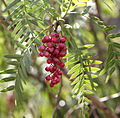Schinus molle
| Schinus molle subsp. var. | Pepper tree | |||||||||||||||||||||||||||||||||||||||||||||||||||||||
|---|---|---|---|---|---|---|---|---|---|---|---|---|---|---|---|---|---|---|---|---|---|---|---|---|---|---|---|---|---|---|---|---|---|---|---|---|---|---|---|---|---|---|---|---|---|---|---|---|---|---|---|---|---|---|---|---|

|
|
| ||||||||||||||||||||||||||||||||||||||||||||||||||||||
| ||||||||||||||||||||||||||||||||||||||||||||||||||||||||
Peruvian Pepper (Schinus molle, also known as American pepper, Peruvian peppertree, escobilla, false pepper, molle del Peru, pepper tree,[1] peppercorn tree, Californian pepper tree, pirul and Peruvian mastic.[2]) is an evergreen tree that grows to 15 meters (50 feet). It is native to the Peruvian Andes. The bright pink fruits of Schinus molle are often sold as "pink peppercorns" although S. molle is unrelated to true pepper (Piper nigrum).
Schinus molle is a quick growing evergreen tree that grows to 15 meters (50 feet) tall and 5-10 meters (16-33 feet) wide.[2] It is the largest of all Schinus species and potentially the longest lived.[3] The upper branches of the tree tend to droop.[2] The tree's pinnately compound leaves measure 8-25 cm long x 4-9 cm wide and are made up of 19-41 alternate leaflets.[2][3] Male and female flowers occur on separate plants.[2] Flowers are small, white and borne profusely in panicles at the ends of the drooping branches.[3] The fruit are 5-7 mm diameter round drupes with woody seeds that turn from green to red, pink or purplish,[2] carried in dense clusters of hundreds of berries that can be present year-round.[3] The rough grayish bark is twisted and drips sap.[2] The bark, leaves and berries are aromatic when crushed.[2]
| Standard Cyclopedia of Horticulture |
|---|
|
Schinus molle, Linn. Peruvian Mastic-tree. Californian Pepper-tree. Evergreen tree, 20 ft. and more, with rounded outline and graceful, pendulous branchlets when not trimmed: lvs. 9 in. or more long, glabrous, of many alternate, linear-lanceolate lfts. 1 1/2- 2 in. long: fls. in conical panicles, yellowish white: ripe frs. the size of peppercorns (whence the popular, but misleading, Californian name), of a beautiful rose- color. Peru.—In S. and Cent. Calif, more extensively cult. than any other ornamental tree except, perhaps, the blue gum (Eucalyptus globulus), and thriving best in the warm interior valleys, though hardy on the coast at San Francisco. Valued as a lawn and avenue tree; often planted as a street tree, for which, however, it is unsuited, being too spreading and branching too low. Molle was a generic name used by Tournefort, and placed in apposition with Schinus by Linnaeus (explained above). CH
|
Cultivation
Propagation
The tree reproduces through seed and suckers.[2] Seeds have a particularly hard coat and germination rates are greatly improved after seeds have passed through the gut of birds or other animals.[2] Seeds germinate in spring, with seedlings slow growing until established.[2]
Pests and diseases
Varieties
Gallery
References
- ↑ http://plants.usda.gov/java/profile?symbol=SCMO
- ↑ 2.00 2.01 2.02 2.03 2.04 2.05 2.06 2.07 2.08 2.09 2.10 Environmental weeds: a field guide for SE Australia, ISBN 0957908601
- ↑ 3.0 3.1 3.2 3.3 Schinus molle L. (Anacardiaceae) Chicha production in the Central Andes, Economic Botany
- Standard Cyclopedia of Horticulture, by L. H. Bailey, MacMillan Co., 1963
External links
- w:Schinus molle. Some of the material on this page may be from Wikipedia, under the Creative Commons license.
- Schinus molle QR Code (Size 50, 100, 200, 500)



